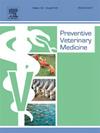Revisiting Mycobacterium bovis SB0121 genetic diversity reflects the complexity behind bovine tuberculosis persistence in Spain
IF 2.2
2区 农林科学
Q1 VETERINARY SCIENCES
引用次数: 0
Abstract
Identifying the causes of tuberculosis (TB) chronicity in cattle herds in Spain is a complex endeavour, mainly due to the multiple factors involved in persistence and the clonal population structure of the Mycobacterium tuberculosis complex. This study assessed the genomic diversity among M. bovis isolates belonging to SB0121, the most prevalent genotype in Spain, in chronically-infected herds. A total of 70 M. bovis isolates from 22 herds, located in six Spanish provinces, in which M. bovis SB0121 was isolated in at least three different sampling events were sequenced. Forty-three isolates from wildlife and cattle herds from the same or neighbouring municipalities to the problem herds were also included to identify putative local transmission events. The within-herd analysis revealed a highly complex scenario, in which the majority (95.45 %; n = 21) of the herds were affected by highly distant strains (> 12 SNP differences), probably as a result of separate introductions. Highly similar isolates (< 6 SNPs) were retrieved in different sampling events from 11 herds, likely indicating active transmission of the outbreak strain or continued exposure to the same source of infection. The between-herd and interspecies comparison suggested the occurrence of several putative epidemiological links between cattle and wildlife species from the same or neighbouring municipalities, reflecting the complex epidemiology of the disease in some of the studied areas. The findings of this study highlight the usefulness of whole genome sequencing to study bTB breakdowns and pinpoints its potential for unravelling possible sources of persistence in cattle herds.
重新审视牛分枝杆菌SB0121遗传多样性反映了西班牙牛结核病持久性背后的复杂性
确定西班牙牛群中结核病(TB)慢性的原因是一项复杂的工作,主要是由于涉及结核分枝杆菌复合体的持久性和克隆种群结构的多种因素。本研究评估了在慢性感染畜群中属于西班牙最流行的基因型SB0121的牛分枝杆菌分离株的基因组多样性。共70个 M。对来自西班牙6个省22个畜群的牛分离株进行了测序,其中至少在3个不同的采样事件中分离到了牛分枝杆菌SB0121。还纳入了43株来自同一或邻近城市的野生动物和问题畜群的分离株,以确定假定的当地传播事件。群内分析揭示了一个高度复杂的情景,其中大多数(95.45 %;N = 21)的畜群受到远端菌株(>;12个SNP差异),可能是不同引种的结果。高度相似的分离株(<;从11个畜群的不同采样事件中检索到6个snp),可能表明暴发菌株的活跃传播或继续暴露于同一感染源。畜群之间和物种之间的比较表明,在同一或邻近城市的牛和野生动物物种之间存在几种假定的流行病学联系,反映了该疾病在某些研究地区的复杂流行病学。这项研究的发现强调了全基因组测序在研究bTB分解方面的有用性,并指出了它在揭示牛群中持久性的可能来源方面的潜力。
本文章由计算机程序翻译,如有差异,请以英文原文为准。
求助全文
约1分钟内获得全文
求助全文
来源期刊

Preventive veterinary medicine
农林科学-兽医学
CiteScore
5.60
自引率
7.70%
发文量
184
审稿时长
3 months
期刊介绍:
Preventive Veterinary Medicine is one of the leading international resources for scientific reports on animal health programs and preventive veterinary medicine. The journal follows the guidelines for standardizing and strengthening the reporting of biomedical research which are available from the CONSORT, MOOSE, PRISMA, REFLECT, STARD, and STROBE statements. The journal focuses on:
Epidemiology of health events relevant to domestic and wild animals;
Economic impacts of epidemic and endemic animal and zoonotic diseases;
Latest methods and approaches in veterinary epidemiology;
Disease and infection control or eradication measures;
The "One Health" concept and the relationships between veterinary medicine, human health, animal-production systems, and the environment;
Development of new techniques in surveillance systems and diagnosis;
Evaluation and control of diseases in animal populations.
 求助内容:
求助内容: 应助结果提醒方式:
应助结果提醒方式:


